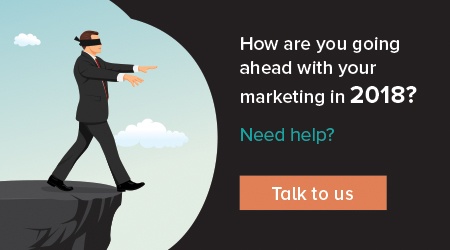Marketers need to start thinking like scientists, not farmers.
There is a growing obsession with marketing automation, content marketing, social media, and a whole bunch of lead generation strategies that lean towards a “set and forget” approach to marketing and growth.
Don’t get me wrong, this way of marketing plays a role, but it also encourages laziness.
Everyone is chasing a pot of gold at the end of the rainbow that will allow them to put up their feet and watch the bots do all of the lead generation work. Unfortunately, that pot doesn’t exist.
Instead of laying seeds in a field and waiting for them to grow into something worthwhile, it’s time you got proactive.
Marketing is about testing, failing, testing again, and being ready to adapt. Especially in a digital world, if you wait for the seeds to sow you’ll get left behind.
So how do you take a scientific approach to lead generation strategies?
It’s about replacing the set and forget mentality and embracing something a little more experimental – time-bound lead generation campaigns.
What is a time-bound lead generation strategy?
Just as the name suggests, a time-bound lead gen campaign runs for a set amount of time. This approach to marketing leverages powerful elements of buyer psychology to create urgency, scarcity, and “buzz” for your business. It also enables you to test, iterate, and optimise your approach by creating short feedback loops.
A well-executed lead gen campaign has three vital elements:
- A climax. An end date that the campaign builds towards.
- Compelling content. The marketing assets used during the lead gen campaign are on-brand, build suspense, and elicit key emotions from participants.
- Social proof. The content and delivery of the campaign are supported by proof points such as testimonials, social buzz, and proven outcomes for the participants.
How, then, do you tap into the power of time-bound lead gen campaigns for your business?
5-Steps to Plan a Time-Bound Lead Gen Campaign
Step 1: Define a target audience for the campaign
Did you know that lead-gen campaigns that target specific buyer personas are 2-5 times more effective?
It’s not surprising, because we are confronted with a growing amount of information online and consumers are trying to block things out at every opportunity. They don’t want to be sold too.
What they do want, however, is to be understood. For their problems to be solved. For their dreams to be realised.
Getting to know your ideal customers intricately by defining a buyer persona for your campaign will undoubtedly deliver you better lead generation outcomes. You will know which platforms to market your offer. You will know which words to use in your copy. You will know their objections, their buying triggers, and the kind of offer they are likely to engage with.
The more narrow and specific your target audience, the more compelling your copy will be.
For example, over the years my agency has delivered above average SEO results for several Australia restaurant chains, so we ran a campaign with an eBook that specifically targeted this customer group:
Step 2: Come up with an offer
What can you offer that will persuade your prospects to take action?
The challenge with coming up with a compelling offer for your lead-gen campaign is making it worthwhile for everyone. The perceived value for your customers obviously needs to be high for it to create interest. But of course, you also need to make a profit, otherwise, what’s the point, right?
Too many businesses jump straight into offering discounts. This approach is ok every once in a while, but if you are following the regular lead generation strategies and always offering discounts, then you become the “discount business”. People begin to devalue your product or service, and others simply wait until you have a discount offer available again. No one ever buys what you sell for what it’s actually worth!
Instead of discounting your product or service, think of ways you can add more value for the same price. Here is a video of Derek Halpern talking about this concept:
Step 3: Plan the campaign
Once you have a clear definition of your target audience, and a compelling offer to promote, it’s time to plan the execution of your campaign.
There are three key areas you need to plan when it comes to your lead-gen campaign:
- Marketing channels. Determine which marketing channels are most relevant for your target audience. You don’t want to spread yourself thin across too many different channels, but you want to create a multi-touch effect so that targets are exposed to your message more than once.
- Events. Create a timeline of the critical events that make up your campaign. The most obvious ones will be the start and end date, but others may include price rises, additional bonuses, publication of important content, and the alteration of ad campaigns.
- Promotion. A fundamental mistake many businesses make with lead-gen campaigns is relying too heavily on organic reach and a few sporadic advertisements. To get the most out of your campaign you need to strategically promote it for the whole duration, across multiple channels. Think about how you can leverage paid and organic social media, blog content, email marketing, industry influencers, and any other promotion methods that make sense.
Use a campaign planning tool like FlypChart, marketing calendar like CoSchedule, or project management platform like Asana to plan and track all of these important elements.
Step 4: Create marketing assets
For your campaign to be successful there is a lot of content and collateral that needs to be created. Blog posts, email broadcasts, landing pages, ad copy, social media images, and so on.
All of these elements need to work together as one. They should have a consistent design and perfectly complement each other as a team of assets that deliver on your expectations for the campaign.
To create these assets, you have a few options:
- Tap into internal resources. If you have content creators, designers, and copywriters in-house, then leverage their skills.
- Hire freelancers or contractors. An option is to find and recruit various marketing freelancers who are skilled in creating each of the assets you need.
- Work with a digital agency. Alternatively, you can work with a digital agency who has the team and resources to deliver all of the assets you need, provide expertise about the campaign planning, and help you achieve your outcomes.
Step 5: Track and optimise
Before your campaign starts it’s vital that you determine the metrics you want to track. It’s easy to get lost in data overload by recording every metric under the sun, but in reality, you just want to measure the numbers that contribute to leads and sales for your business.
While analysing your lead generation strategies, ask yourself, which customer events along the timeline of your campaign will have the biggest influence on the likelihood of a purchase? How can you determine the success of these events with hard metrics?
Once you know what metrics to stay on top of, set a baseline, track their performance, and optimise your campaign as you go.
If the campaign is a scientific test, then create mini-tests within that campaign. Optimise, optimise, optimise, and continue to set new benchmarks for performance.
Tools like Google Analytics and Klipfolio work well to give you a campaign-wide view of your metrics.
What’s stopping you from running a time-bound lead generation campaign right now?












